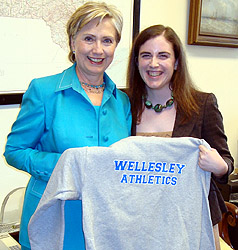Ramifications Of The NCAA Decision To Eliminate Squash
As An 'Emerging Sport'
by Sarah Odell, special to DailySquashReport.com
July 19, 2011 - When the NCAA decided late in 2010 to cut squash from the emerging sport list, most people didn’t notice the decision, let alone realize the profound impact on the sport moving forward. But this decision is like hitting the serve out at nine-all in the fifth.
Some background: 14 years ago the National Collegiate Athletic Association (NCAA) created an emerging sport list with the goal of having the nine original sports one day become official sponsored NCAA sports. Squash was on that list. Emerging status (only applicable to women’s sports) is bestowed on sports which the NCAA thinks have promise. The status provides for a 10-year window to build teams with the goal of reaching at least 40 college programs, the minimum required to become an official NCAA sport. As an incentive while in emerging status, colleges can count the women who play on those teams toward meeting Title IX requirements.
What’s happened? Of the nine original sports on the list, four have become “championship” sports: rowing, ice hockey, water polo and bowling. In the case of women’s squash, after the 10-year window, the NCAA granted the sport four extra years to reach the critical mass of 40 teams. Right now we’re at about 29. So in 2010, the Committee on Women’s Athletics and the NCAA Division 1 Council decided to drop the sport.
Does NCAA sponsorship really matter? Yes. Here’s why this decision hurts women’s squash:
1) Colleges now have no incentive to add squash as a varsity sport. Before the 2010 decision, colleges could add women’s varsity squash in order to fulfill Title IX requirements. Now there is no incentive – all the more so because the sport is seen as stagnant and incapable of growth.
2) Branding. With squash enthusiasts pushing for inclusion of the sport in the Olympics, one must look at how to brand the sport into being a nationally-recognized powerhouse. The NCAA brings national recognition and visibility to every sport it sponsors. Some may argue that this is in name only, but we cannot discount the importance of NCAA sponsorship and inclusion.
3) Women’s squash is not growing at the same rate as the men. During my time in college (2006-2010), the men’s College Squash Association almost doubled in size to over 60 teams. Most people when they heard about the NCAA’s decision cited this. But the men’s growth, while encouraging, is irrelevant. You need 40 varsity teams on the women’s side. If we can’t get 40 colleges to sponsor women’s varsity squash, how do we expect to get women to fill the draws at the US Nationals, National Doubles and Howe Cup? Also, why are colleges adding men’s programs, and not women’s programs? (At both club and varsity levels). Something is clearly amiss here, and must be addressed.
4) Resources (and the pipeline). One current discussion among the women: Why aren’t more female players becoming coaches or going into the administrative side of squash, at collegiate, interscholastic and national levels? The NCAA holds workshops for college athletes, including specialized ones to encourage women to become coaches and administrators. The problem? Squash athletes are not included in these workshops, because we aren’t an NCAA sport.
5) Limiting geographic and socioeconomic range of squash athletes. With squash as a recognized NCAA sport, colleges like George Washington University added programs. Division I colleges are the only US colleges that can give athletic scholarships. Division III and Ivy League institutions cannot. With more Division I schools like GW adding squash, scholarships can be a tool for bringing in a more diverse group of players and broadening support for the sport. Without access to NCAA status – and scholarships – women’s squash will remain an elite, Northeast game even as the men’s game reaches new audiences and players.
About the Author:
A 2010 graduate of Wellesley College, Sarah Odell was a four-year member of the squash team and two-year co-captain. Now living in New York City where she works for HarperCollins publishers, Sarah is an active member of the New York and national squash scenes. She serves on the boards of Maccabi USA Squash, the Women’s Doubles Squash Association, and the Metropolitain Squash Racquets Association. When Sarah isn’t reading or on a court, she enjoys good food and good company.

Back To Main
